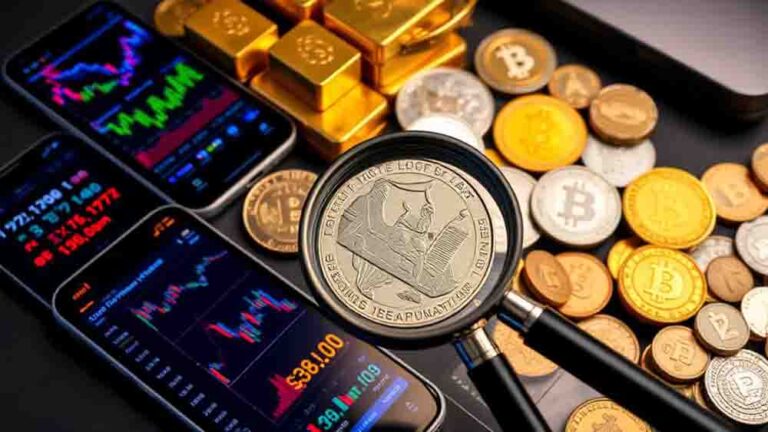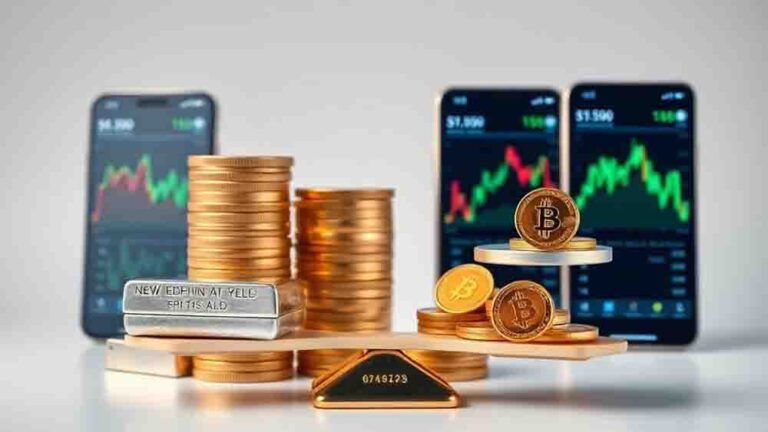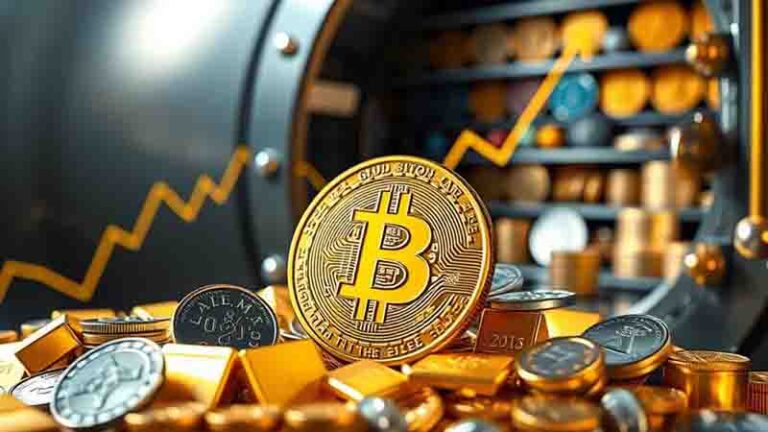Why Hedge Against Inflation With Precious Metals and Bitcoin?
Note: This post may contain affiliate links, and we may earn a commission (with No additional cost for you) if you purchase via our link. See our disclosure for more info. The gold and crypto world is constantly changing. This is not financial, investment, legal, or professional advice. So, please verify the information on the gold and cryptocurrency provider’s websites.
You've likely noticed the rising costs of everyday goods and services, but have you considered how inflation might be eroding your long-term savings? As central banks continue to print money and interest rates remain low, your purchasing power could be silently diminishing. Precious metals and Bitcoin have emerged as popular hedges against this financial erosion, offering unique properties that may help preserve your wealth. But why are these particular assets gaining traction, and how do they compare in the fight against inflation? The answers might surprise you and could greatly impact your financial strategy.
Key Takeaways
- Precious metals, especially gold, have a proven track record as inflation hedges, maintaining value during economic turmoil.
- Bitcoin's fixed supply of 21 million coins creates scarcity, potentially protecting against currency devaluation.
- Both assets offer portfolio diversification, enhancing resilience against economic uncertainties and inflationary pressures.
- Institutional adoption of Bitcoin alongside traditional precious metals reflects changing perceptions of effective inflation hedges.
- Combining Bitcoin and precious metals leverages their unique strengths, balancing stability with growth potential against inflation.
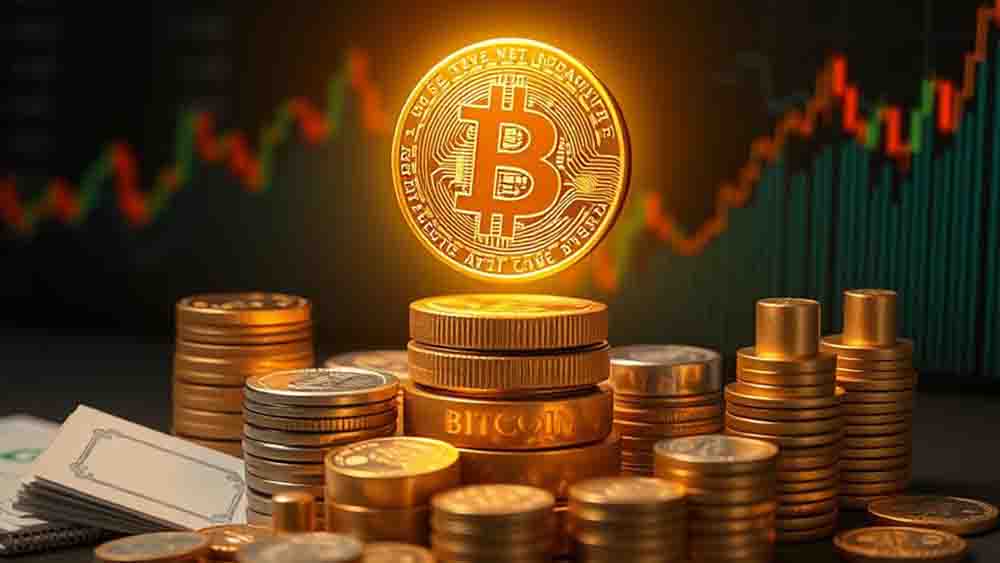
Understanding Inflation's Impact on Wealth
Inflation's insidious effect on wealth can't be overstated. As prices rise over time, the purchasing power of your money decreases, eroding the value of your savings and investments. This silent wealth destroyer has averaged around 3% annually in the U.S., but has reached double digits during periods of economic turmoil, such as the 1970s.
The Consumer Price Index (CPI) serves as a key indicator of inflation, measuring the cost of living. When the CPI increases, it signals that your dollars are buying less, potentially leading to reduced consumer spending and economic instability.
To combat this wealth erosion, many investors turn to inflation hedges. Precious metals, particularly gold, have long been recognized as effective inflation hedges. These tangible assets tend to appreciate in value as fiat currencies depreciate, preserving wealth during inflationary periods.
Additionally, Bitcoin has emerged as a digital alternative for hedging against inflation. With its fixed supply of 21 million coins, Bitcoin offers a potential store of value in an increasingly digital world.
Understanding inflation's impact on wealth is essential for making informed investment decisions and protecting your financial future.
The Case for Precious Metals
As we explore strategies to protect wealth from inflation's erosion, precious metals stand out as a time-tested solution. Gold, in particular, has consistently demonstrated its ability to serve as a reliable hedge against inflation throughout history.
Unlike newer assets such as Bitcoin, gold's tangible nature and long-standing reputation provide a sense of security for conservative investors seeking stability in their portfolios.
Gold's effectiveness as an inflation hedge stems from several factors:
- Diverse demand sources: Industrial uses, jewelry, and central bank purchases contribute to gold's strategic value.
- Historical performance: Gold tends to appreciate during high inflation periods, protecting against currency devaluation.
- Global recognition: Widely accepted as a safe-haven asset, gold outperforms Bitcoin in inflationary environments.
When you invest in gold, you're tapping into a proven strategy for preserving wealth.
Its ability to retain value when fiat currencies depreciate makes it an essential component of a well-diversified portfolio.
Bitcoin's Role in Modern Portfolios
Bitcoin's emergence as a diversification tool in modern investment portfolios has caught the attention of institutional and retail investors alike.
You'll find that many hedge funds and family offices are now allocating up to 5% of their portfolios to Bitcoin, recognizing its potential to enhance risk-adjusted returns.
This trend highlights Bitcoin's growing role as a strategic asset, particularly in hedging against inflation risks and economic uncertainty.
Diversification Benefits
Modern investment portfolios are increasingly incorporating Bitcoin as a strategic asset for diversification. This digital currency offers unique benefits that can help hedge against inflation and enhance overall portfolio performance. Bitcoin's fixed supply of 21 million coins creates artificial scarcity, making it an attractive option for investors seeking protection from inflationary pressures.
Research indicates that adding Bitcoin to a diversified portfolio can improve risk-adjusted returns and reduce volatility. Its low correlation with traditional assets provides diversification benefits, particularly during periods of economic uncertainty. Here's a comparison of Bitcoin's diversification benefits:
| Feature | Traditional Assets | Bitcoin |
|---|---|---|
| Supply | Variable | Fixed (21 million) |
| Liquidity | Varies | High |
| Ownership | Physical/Digital | Digital |
| Inflation Protection | Limited | Strong potential |
Institutional investors are increasingly recognizing Bitcoin's potential as a strategic asset. Surveys show growing confidence in its long-term value and ability to enhance portfolio performance. Unlike traditional assets, Bitcoin offers easy portfolio adjustments due to its digital nature and high liquidity. By incorporating Bitcoin, you can potentially improve your portfolio's overall performance and protect against inflationary pressures.
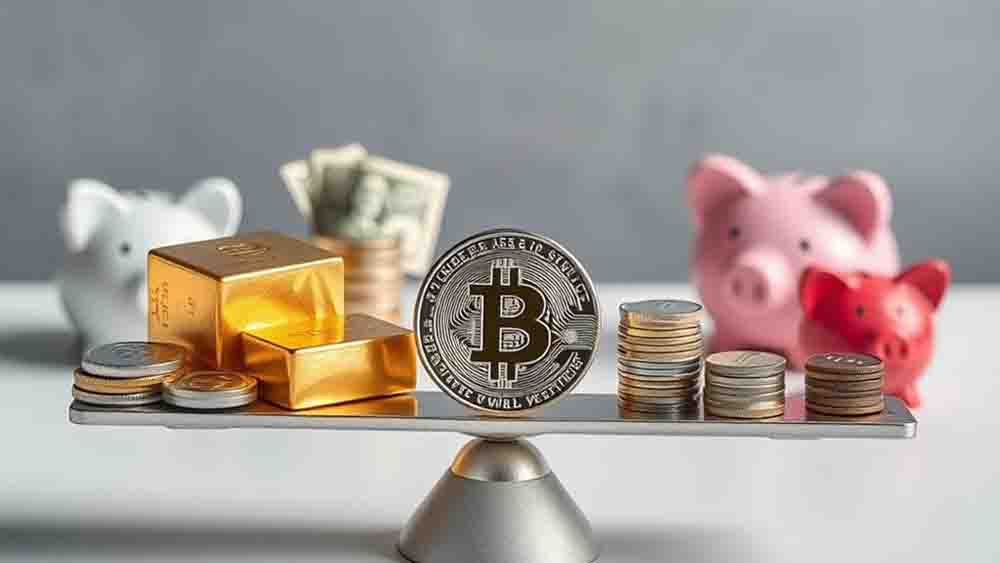
Institutional Adoption Trends
Institutional investors are rapidly embracing Bitcoin as a strategic asset in modern portfolios. This trend reflects a significant shift in perception, with major players like BlackRock's Larry Fink recommending a 5% allocation to Bitcoin as a hedge against inflation. The growing confidence in Bitcoin's long-term value among institutional investors marks a change from initial skepticism to active investment.
Key factors driving institutional adoption:
- Regulatory clarity
- Recognition of Bitcoin as a potential primary digital currency
- Inflationary pressures
Family offices and hedge funds are increasingly diversifying their portfolios with Bitcoin, integrating it alongside traditional assets like gold and real estate.
The introduction of Bitcoin ETFs has simplified access for institutional investors, facilitating broader adoption and integration into diversified investment strategies.
Bitcoin's market maturity, characterized by increased trading volume and institutional interest, positions it as a viable alternative asset class.
As institutional adoption grows, Bitcoin's role as a hedge against inflation becomes more prominent. This trend suggests that Bitcoin is evolving into a mainstream financial instrument, offering potential benefits for investors seeking to protect their portfolios against economic uncertainties and inflationary pressures.
Comparing Gold and Bitcoin Performance
Over the past decade, investors have closely watched the performance of gold and Bitcoin as potential hedges against inflation. Gold has maintained its long-standing reputation as a reliable inflation hedge, consistently retaining value during inflationary periods. Its price typically rises in response to inflationary pressures, attracting conservative investors seeking stability in uncertain times.
Bitcoin, on the other hand, has emerged as a newer option with less historical data to support its effectiveness as an inflation hedge. While it's gained popularity among risk-takers and is increasingly viewed as a diversification tool, Bitcoin's price movements have shown greater volatility compared to gold.
When comparing their performance:
- Gold demonstrates a well-documented correlation with inflation, often appreciating as demand increases.
- Bitcoin's historical performance doesn't exhibit a consistent inverse relationship with inflation trends.
- In inflationary environments, gold tends to behave more predictably as a store of value.
- Bitcoin sometimes acts more like a speculative asset, leading to differing investor perceptions.
While both assets have their merits, gold remains the preferred choice for many financial experts as a traditional and proven inflation hedge.

Diversification Benefits of Both Assets
Investors looking to hedge against inflation can benefit from diversifying their portfolios with both precious metals and Bitcoin. This combination offers enhanced resilience against economic uncertainties and currency devaluation.
Gold and Bitcoin: Complementary Hedges
- Gold: Tangible asset with historical value preservation
- Bitcoin: Digital asset with fixed supply and quick liquidity
By allocating a portion of your portfolio to both assets, you're leveraging their unique strengths:
- Varied Correlation: Bitcoin's fluctuating correlation with traditional assets provides diversification benefits, while gold typically maintains a negative correlation with inflation.
- Distinct Demand Drivers: Gold benefits from jewelry and industrial use, whereas Bitcoin gains value from growing acceptance as a payment method and institutional backing.
- Performance During Economic Stress: Gold has consistently appreciated during downturns, while Bitcoin offers potential for high returns and serves as a hedge against currency devaluation.
- Risk Mitigation: Combining these assets can improve risk-adjusted returns.
Institutional investors suggest allocating a small percentage to Bitcoin alongside traditional hedges like gold.
Risks and Volatility Considerations
The roller coaster of volatility presents a stark contrast between Bitcoin and precious metals as inflation hedges. When considering these assets, you'll need to weigh the risks and volatility carefully. Bitcoin's price fluctuations can be extreme, with daily swings often exceeding 10%, while precious metals like gold typically experience more modest movements. This volatility difference impacts your investment strategy and potential returns.
Consider these key points:
- Bitcoin's regulatory uncertainty may affect its price and adoption.
- Precious metals have established frameworks, providing stability.
- Technological vulnerabilities pose risks for Bitcoin investors.
Precious metals offer a more stable option during economic downturns, maintaining value consistently. In contrast, Bitcoin's volatility can lead to substantial short-term losses. However, this volatility also presents opportunities for significant gains.
You should also be aware of the security risks associated with Bitcoin, including potential hacking of exchanges. Precious metals, being physical assets, are less susceptible to such threats.
Ultimately, your choice between Bitcoin and precious metals as inflation hedges will depend on your risk tolerance and investment goals. Consider diversifying across both to balance potential risks and rewards.

Implementing a Balanced Hedging Strategy
To implement a balanced hedging strategy against inflation, you'll need to diversify your investments across different asset classes, including precious metals and Bitcoin.
You should consider allocating 5-10% of your portfolio to Bitcoin, as suggested by institutional leaders, while maintaining a core position in gold for its proven stability.
It's essential to adjust these allocation percentages regularly, taking into account changing market conditions and inflation rates, to guarantee your hedging strategy remains effective in protecting your wealth.
Diversification Across Asset Classes
With inflation concerns on the rise, implementing a balanced hedging strategy through diversification across asset classes has become increasingly essential.
By combining precious metals like gold with cryptocurrencies such as Bitcoin, you can create a robust portfolio that's better equipped to withstand inflationary pressures. This approach leverages the stability of gold, which has historically outperformed during inflationary periods, alongside Bitcoin's potential for high returns and its fixed supply cap.
A diversified asset allocation strategy can offer several benefits:
- Enhanced portfolio resilience against inflation
- Balanced risk-reward profile
- Potential for improved risk-adjusted returns
Institutional investors are increasingly recognizing the value of including Bitcoin in a diversified portfolio.
By allocating a portion of your investments to both gold and Bitcoin, you can hedge against inflation while maintaining exposure to growth opportunities. Gold provides stability and a proven track record, while Bitcoin offers the potential for significant returns and acts as a counterbalance to fiat currency devaluation.
This balanced approach allows you to capitalize on the strengths of each asset class, creating a more robust hedge against inflationary pressures.
Adjusting Allocation Percentages
Implementing a balanced hedging strategy against inflation requires careful consideration of allocation percentages between precious metals and Bitcoin. Experts typically recommend allocating 5-10% of your portfolio to Bitcoin and a higher percentage to gold, depending on your risk tolerance. This approach allows you to benefit from both assets' unique characteristics in combating inflation.
When adjusting allocation percentages, consider the following:
- Historical performance: Gold has consistently outperformed Bitcoin in inflationary environments, making it a vital component of your strategy.
- Bitcoin's fixed supply: The 21 million coin limit can create scarcity, potentially beneficial for hedging, but its volatility requires careful management.
- Institutional trends: 70% of institutional portfolios now include Bitcoin alongside traditional assets like gold, reflecting a growing recognition of diversification's significance.
To optimize your hedging strategy:
- Regularly rebalance your allocations based on market conditions and inflation trends.
- Monitor the performance of both bitcoin and gold to guarantee your portfolio remains aligned with your risk tolerance and financial goals.
- Stay informed about macroeconomic factors that may impact inflation and adjust your strategy accordingly.
Future Outlook for Inflation Hedges
Increasingly, the future outlook for inflation hedges points toward a diversified approach that includes both traditional and emerging assets. As economic uncertainties persist, you'll likely see a growing interest in bitcoin as an inflation hedge alongside established options like precious metals. This emerging asset class is gaining traction due to its decentralized nature and potential for long-term value preservation.
The future landscape of inflation hedges may evolve in the following ways:
- Enhanced technological infrastructure improving Bitcoin's usability and security
- Decreased volatility in Bitcoin prices as adoption broadens
- Increased institutional investment in cryptocurrencies as a portfolio diversification tool
You can expect ongoing technological advancements to bolster Bitcoin's position as a viable inflation hedge. These improvements will likely enhance its appeal to both individual and institutional investors seeking alternatives to traditional assets.
As regulatory frameworks develop, you may see a more defined role for Bitcoin in investment strategies.
While precious metals will likely maintain their status as time-tested inflation hedges, Bitcoin's growing acceptance could lead to a more balanced approach. You should consider how this evolving landscape might impact your long-term investment strategy and risk management practices.
Frequently Asked Questions
Is Bitcoin a Good Hedge Against Inflation?
Bitcoin's potential as an inflation hedge is debatable. You'll find arguments for both sides.
Its fixed supply and historical performance during inflationary periods suggest it could protect your wealth. Many institutional investors now view it as a strategic asset.
However, Bitcoin's high volatility and speculative nature raise concerns about its long-term reliability. As more investors adopt it, its role as an inflation hedge may strengthen.
Consider your risk tolerance and investment goals before deciding if Bitcoin fits your portfolio.
Are Precious Metals a Good Hedge Against Inflation?
Precious metals, especially gold, are indeed considered a good hedge against inflation.
You'll find that they often maintain or increase their value during periods of rising inflation. Their limited supply and intrinsic worth make them attractive when fiat currencies lose purchasing power.
Gold's diverse demand from industries, jewelry, and central banks further enhances its appeal. As tangible assets, precious metals offer you a sense of security during economic uncertainty.
However, it's important to remember that no investment is without risk.
What Asset Is the Best Hedge Against Inflation?
When considering the best hedge against inflation, you'll find that both gold and Bitcoin have their merits.
Gold has a long-standing reputation as a reliable inflation hedge, consistently maintaining value during economic downturns. It's favored by conservative investors for its tangibility and established demand.
Bitcoin, on the other hand, offers digital scarcity and appeals to risk-takers. While gold has historically outperformed Bitcoin during inflationary periods, some institutional investors now view Bitcoin as a valuable diversification tool, recommending a 5% portfolio allocation.
Why Is Gold Used to Hedge Against Inflation?
You'll find gold is a popular hedge against inflation for several reasons.
It's historically maintained its value during economic downturns and often appreciates when inflation rises.
Gold's diverse demand sources, including jewelry and industrial uses, contribute to its stability.
As a tangible asset, it provides a sense of security during uncertain times.
Gold's inverse correlation with inflation makes it attractive for preserving purchasing power.
Its long-standing reputation and widespread acceptance make it a reliable choice for investors seeking protection from inflationary pressures.
Conclusion
You've learned why hedging against inflation with precious metals and Bitcoin is essential for protecting your wealth. By combining gold's stability and Bitcoin's growth potential, you're creating a balanced strategy to combat rising prices. Remember to take into account the risks and volatility of each asset, and implement a diversified approach tailored to your financial goals. As economic uncertainties persist, these inflation hedges will likely remain valuable tools for preserving your purchasing power in the years to come.








